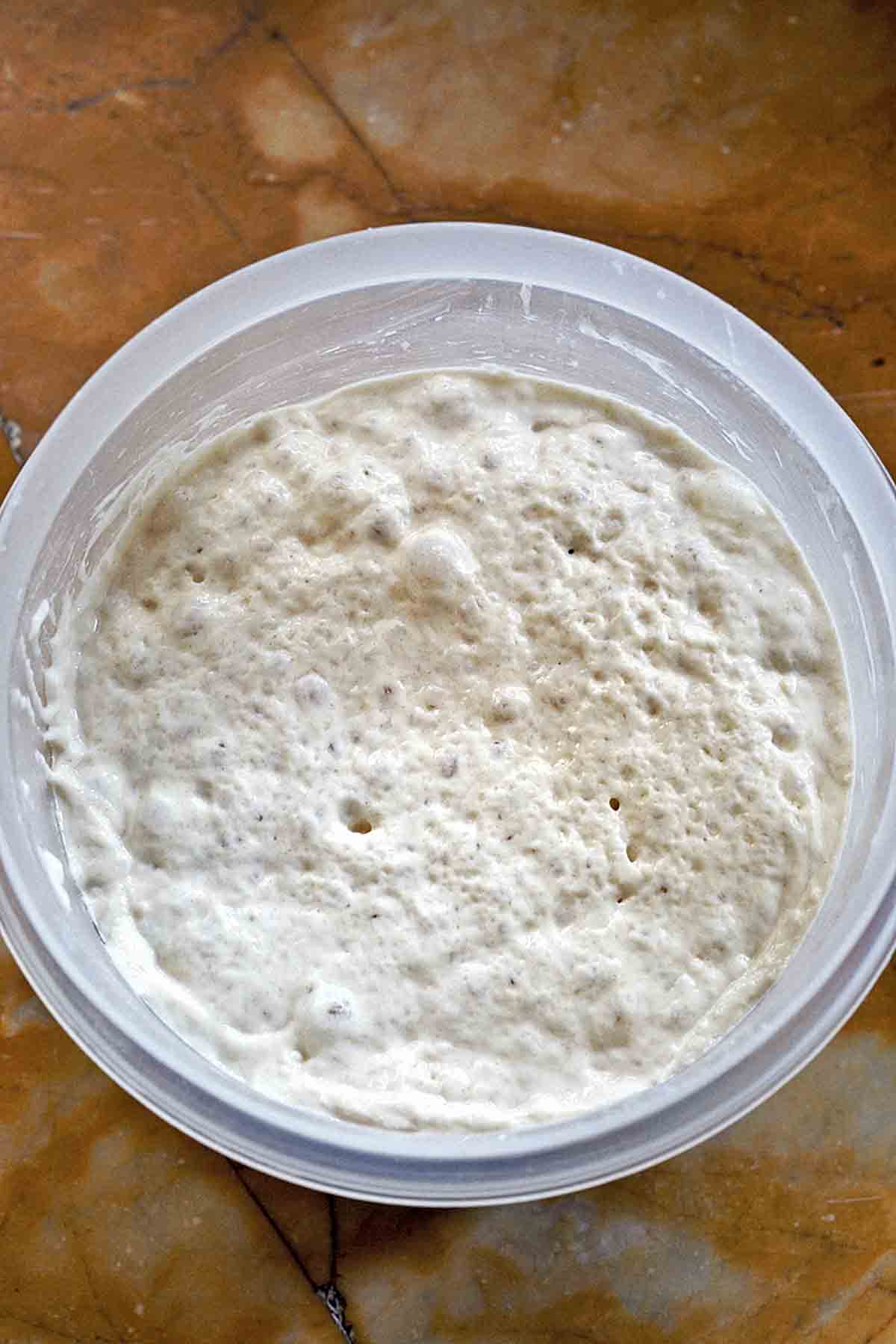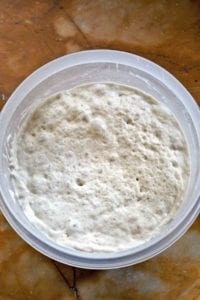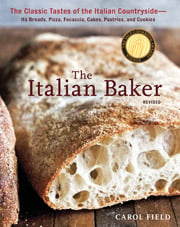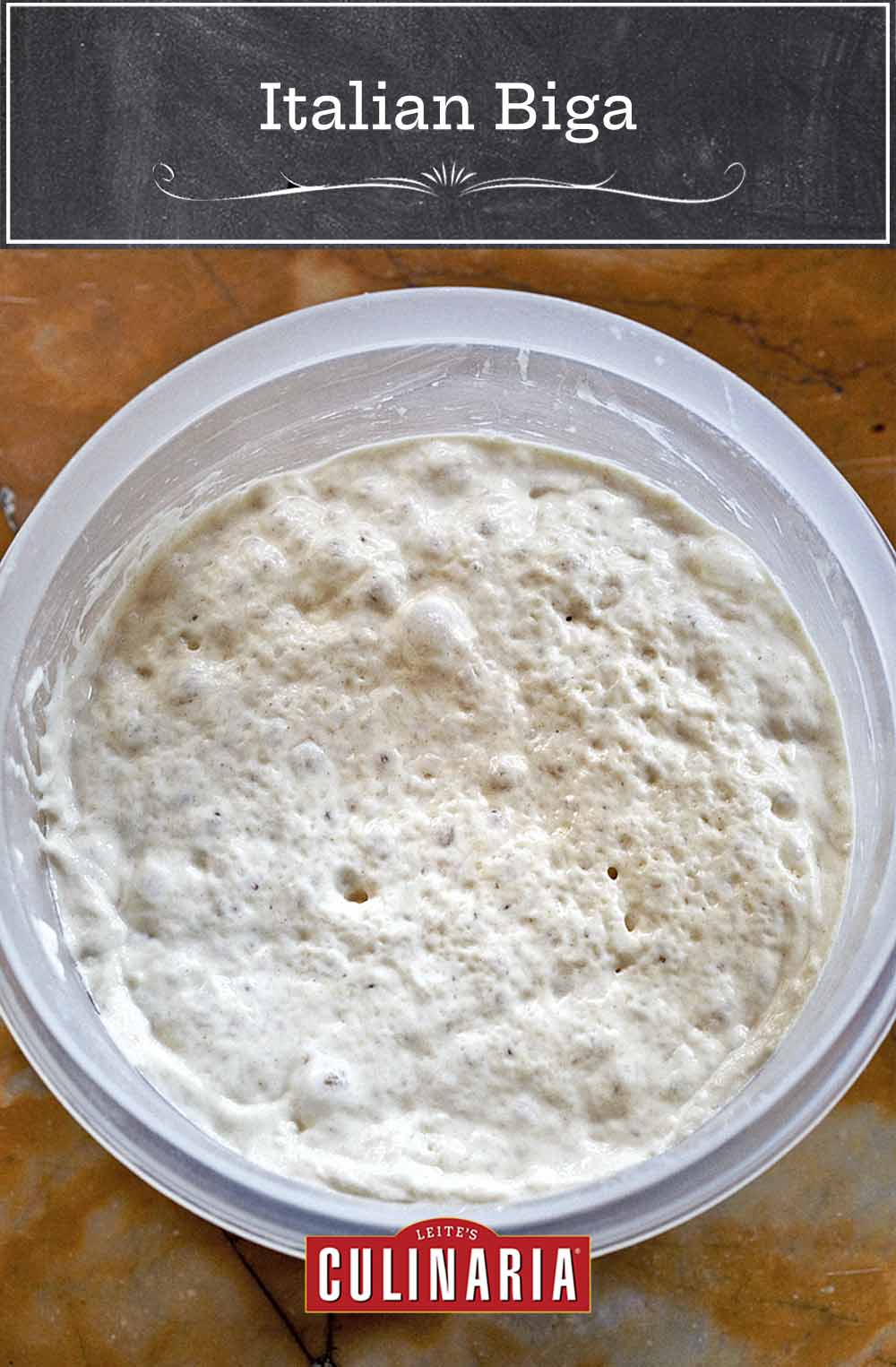
Many of the recipes for classic regional breads, such as this ciabatta recipe, begin with a starter dough made from small amounts of flour, water, and yeast allowed an initial fermentation. The starter, known as biga in Italy, or bighino when in small amounts, not only gives strength to what in Italy are weak flours, it also produces a secondary fermentation from which come the wonderful aroma, natural flavor, and special porosity of the final loaves and wheels of bread.
The important point about a biga is that the breads made with it develop a wonderful taste because their risings are long and bring out the flavor of the grain. Another benefit is that the loaves remain fresher and taste sweeter than those made with large amounts of commercial yeast.
In Italy, bakers use dough from the previous day’s baking to start a new dough. I keep some starter on hand at all times; by having it around, I can decide to make pane pugliese or ciabatta in the morning and have it for dinner that night. Because the first biga must come from somewhere, though, you may make it following the instructions below. It’s remarkable. It freezes very well and needs only about 3 hours at room temperature until it is bubbly and active again, or it can be refrigerated for up to 5 days.–Carol Field
LC Obliged to Biga Note
Behind each and every memorable bite of proper Italian bread we’ve daintily nibbled, hungrily inhaled, or otherwise somehow consumed, we have a biga to thank. So we’re feeling much obliged to Carol Field for this recipe. Nonna not included.

Italian Biga
Ingredients
- 1/4 teaspoon active dry yeast
- 1/4 cup warm water, 100°F to 110°F (38°C to 43°C)
- 3/4 cup plus 4 teaspoons bottled spring water, at room temperature (You can use tap water in a pinch.)
- 2 1/3 cups unbleached all-purpose flour
- vegetable oil, for the bowl
Instructions
- Stir the 1/4 teaspoon active dry yeast into the 1/4 cup warm water and let stand until creamy, about 10 minutes.
- Stir the 3/4 cup plus 4 teaspoons bottled spring water into the creamy yeast mixture, and then stir in the 2 1/3 cups unbleached all-purpose flour, 1 cup at a time. ☞ If mixing by hand, stir with a wooden spoon for 3 to 4 minutes. ☞ If mixing with a stand mixer, beat with the paddle at the lowest speed for 2 minutes. If mixing with a food processor, mix just until a sticky dough forms.
- Transfer the biga to a bowl lightly coated with vegetable oil, cover with plastic wrap, and let rise at cool room temperature for 6 to 24 hours, until the starter is triple its original volume but is still wet and sticky. (The bakers I admire most advise 10 to 11 hours for the first rise, but others are very happy with the 24 hours it takes for dough to truly become yesterday’s dough, and if you like sour bread, allow your biga to rest for 24 to 48 hours or even 72 hours.)
- Cover and refrigerate or freeze the biga until ready to use. (If refrigerating the biga, use within 5 days. If freezing the biga, let it rest at room temperature for about 3 hours until it is bubbly and active again.) When needed, scoop out the desired amount of biga for your recipe and proceed. I strongly recommend weighing the biga rather than measuring it by volume since it expands at room temperature. If measuring by volume, measure chilled biga; if measuring by weight, the biga may be chilled or at room temperature.

Nutrition
Nutrition information is automatically calculated, so should only be used as an approximation.
Recipe Testers’ Reviews
This is a perfectly suitable starting point for most any bread which uses a starter. I bake bread several times a week and it’s nice to have this handy. Sometimes I add this to a bread dough which doesn’t call for a starter just for the added flavor.












I keep a biga going in the cool corner of our old farmhouse kitchen. Baking almost daily, I use a lot so it’s handy to have it at the ready all the time. It’s somehow also comforting to see it there, knowing it’s ready to make wonderful bread.
How lovely, Robin! Thanks so much for letting us know.
My biga has been resting at room temperature for 24 hours and has not risen at all if it is too dry…?.what should I do please
Hi Lyn, two things come to mind. Is your yeast fresh and what is your room temperature? If you have any more yeast, you might try proofing it to confirm its viability. Also, if your room is too chilly, that might impact the rise.
I want to try to make ciabatta bread and your recipe calls for a free-standing mixer. I don’t have one of these and cannot run out to buy it. Please advise of the hand-kneading process so I can go trial and error. Thanks.
Janet, like you, I don’t have a free-standing mixer and so I often adapt recipes for hand kneading. This ciabatta is a little different than most bread doughs, though, so I reached out to our resident bread baking expert and professional baking instructor, Cindi Kruth. Here’s what she has to say…
The reader asks for advice on hand kneading. The main points are :
1. It will be wet and sticky. It becomes supple, but never gets to the usual “smooth and elastic” in quite the same way as, say, a white bread dough.
2. Follow the recipe’s advice and DO NOT add excess flour. The wet dough is what produces the lovely, chewy, hole-y crumb.
3. Expect that the dough will stick to your kneading surface and use a plastic dough scraper to scrape it up and fold it over. If the dough is sticking to your hands (very likely), scrape as much as possible off with the dough scraper, wash any remaining bits off, and, without drying your hands, continue kneading. Alternatively, dry your hands completely and apply a light coating of olive oil. The water or oil will help to keep the dough from sticking while you knead without the need for additional flour.
This ciabatta can be a challenge. Especially without a mixer. As the recipe indicates, it can be made in a processor. I have always found very wet doughs such as this make my processor stall, but then my processor is 20 years old so not the strongest of motors. Still, I make lots of dough in it, even my pizza dough which is abut 62% hydration. This ciabatta, at closer to 67 to 68%, is a bit too wet for my machine. That said, since the processing is so short, just 45 seconds, (as it is with all yeast dough made in the processor) it should be doable with a good heavy duty machine. If the machine stalls the dough can be scooped out and finished by hand.
Clearly this and other wet doughs were made by hand before the advent of our modern machines. The recipe doesn’t encourage making the dough by hand because of the tendency of inexperienced bakers to add too much flour to keep the dough from sticking. Wetting the hands is a better option, but this will be a bit of a chore and a little messy to knead by hand in any case.